Saint Therese of the Child Jesus
of the Holy Face
For St. Therese's feast, view the film "In Search of the Little Flower: The Full Life Story of St. Therese"
To my knowledge, the film "In Search of the Little Flower: The Full Life Story of St. Therese" is the only excellent full-length documentary about St. Therese in English legally available for free viewing on the Internet. It was produced in 2019 by Sancta Familia Media (Brian Timmons and John Patrick Mallon), two devout young Catholic Scotsmen who traveled to France with their pastor, Fr. James Grant, then press secretary to the Bishops' Conference of Scotland, to make the film in order to help the people of Scotland prepare for the historic first visit of the relics of St.Therese to Scotland. From then until 2022, more than 58,000 people have viewed it online. I strongly recommend it. Feast on it!
Anniversary of Therese's offering of herself to Merciful Love on June 9, 1895
To recreate this offering on the anniversary, please visit the page "Offering of myself to Merciful Love, June 9, 1895."
"Little Flower's Body Moved from Grave to Carmel Chapel," an account of the transfer of St. Therese's body on March 26, 1923, from the "Pittsburgh Catholic"
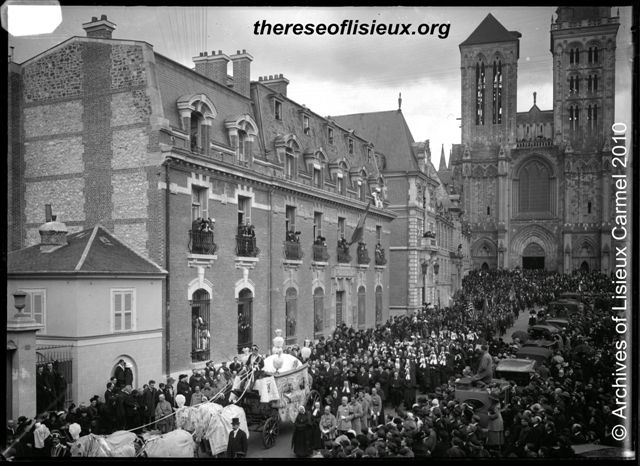 The coffin of the Venerable Therese of the Child Jesus of the Holy Face, en route f rom the town cemetery to Carmel, reaches the town square, before St. Pierre's Cathedral, March 26, 1923
The coffin of the Venerable Therese of the Child Jesus of the Holy Face, en route f rom the town cemetery to Carmel, reaches the town square, before St. Pierre's Cathedral, March 26, 1923
Paris, April 9 - The body of Sister Therese of the Infant Jesus has been taken from the cemetery of Lisieux, where it was buried in 1897, and carried to the Lisieux Chapel of the Carmel, which is to be its final resting place. The ceremony of the translation of the remains of the Little Flower was one of the most inspiring piety and, at the same time, of the most solemn grandeur.
Through the streets of the little Norman town, the coffin of the young Carmelite nun was followed by more than 30,000 people, many of them pilgrims from distant lands. In the procession were seen the khaki uniforms of three members of the American Legion, Captain Huffer and Sergeants Maire and Hum, who carried the American flag.
"It is a true prodigy," said one of the newspapers in commenting on the event, "that a frail young girl who entered the cloister at the age of 16* and died at the age of 24, after a life of isolation and humility unknown to the outside world, should be able, after her death, to inspire such a universal movement of affection and veneration."
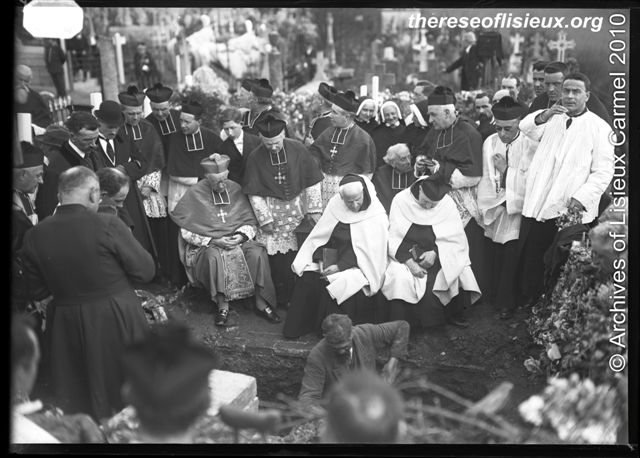 Mgr Lemonnier, bishop of Bayeux and Lisieux; Fr. Rodrigo, O.C.D., Postsulator and Delegate of the Holy See; clergy, nuns, and o thers observe as the gravediggers prepare to exhume the coffin of the Venerable Therese of the Child Jesus of the Holy Face from the earth.
Mgr Lemonnier, bishop of Bayeux and Lisieux; Fr. Rodrigo, O.C.D., Postsulator and Delegate of the Holy See; clergy, nuns, and o thers observe as the gravediggers prepare to exhume the coffin of the Venerable Therese of the Child Jesus of the Holy Face from the earth.
The body of the Little Flower was exhumed for the first time in 1917,** and buried again in the cemetery of Lisieux in a triple coffin of ebony, lead and mahogany. On the occasion of the present exhumation, the delegate of the Holy See, Rev. Father Rodrigo, the Postulator of the Cause at Rome, the Bishop of Bayeux and Lisieux, the members of the family of the young Carmelite, and the civil authorities were all present to see that the coffin was instact.
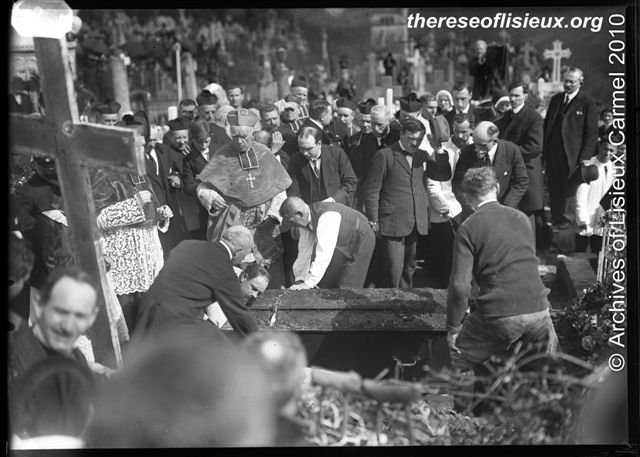 Bishop Lemonnier of Bayeux and Lisieux presides as the gravediggers remove the coffin of the Venerable Therese of the Child Jesus of the Holy Face from the earth.
Bishop Lemonnier of Bayeux and Lisieux presides as the gravediggers remove the coffin of the Venerable Therese of the Child Jesus of the Holy Face from the earth.
At the grave, which was marked by a simple cross of white wood, with black letters, Bishop Lemmonier received the depositions demanded by the Church. The caretaker of the cemetery, who has occupied his post for 20 years, and the sacristan of the Carmel both made oath on the Gospels that they recognized the grave and that they had been present at the various burials and exhumations. Then, when the grave had been opened and the coffin raised, Father Rodrigo observed that the seals placed over the screws of the lid in 1917 were intact.
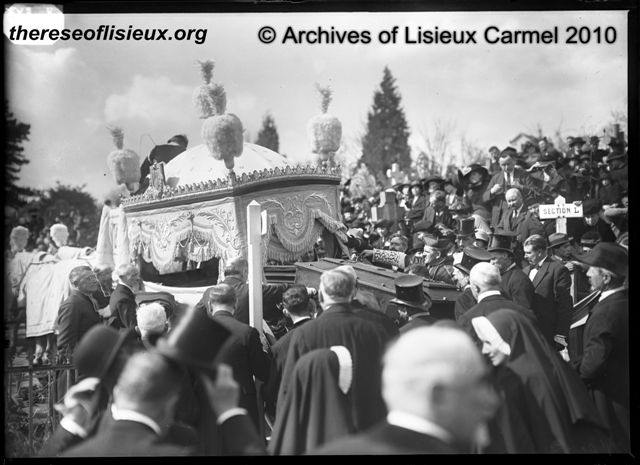 St. Therese's coffin is transferred to the carriage whch will carry it to her Carmel, March 26, 1923
St. Therese's coffin is transferred to the carriage whch will carry it to her Carmel, March 26, 1923
The coffin was then placed on a white hearse drawn by four white horses richly caparisoned with trappings of the same color. On the right and left sides of the hearse were two panels containing portraits of the Little Flower, as traditions [sic] represents her, smiling with infinite sweetness. The coffin was covered with a magnificent cloth of gold, richly embroidered especially for the ceremony.
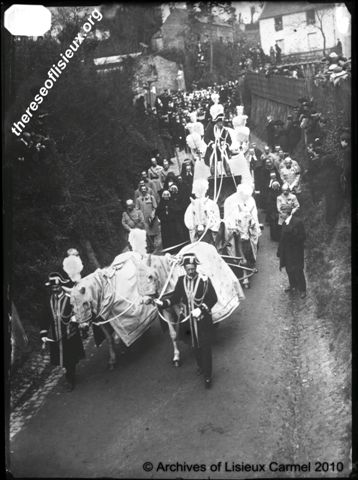 The procession of the coffin of St. Therese travels down the cemetery hill toward the Carmel of Lisieux, March 26, 1923
The procession of the coffin of St. Therese travels down the cemetery hill toward the Carmel of Lisieux, March 26, 1923
The procession moved slowly down the hill from the cemetery to the town, and all along the way the roadsides were lined with men and women who made the sign of the cross while tears of gratitude or hope filled their eyes.
At the four corners of the hearse walked four Carmelite nuns with lowered veils. To the right and left marched a double line of officers, non-commissioned officers and private soldiers, in uniform; all veterans of the late war, who had been cured or protected and who had come to thank the Little Flower for having interceded for them. The lines were headed by a Colonel and several battalion commanders.
Behind the hearse came members of the families related to the Little Flower, and three outdoor sisters*** from the Visitation Convent of Caen, where one of the sisters of the young Carmelite still lives. Next came delegations from the Catholic schools, clubs, and societies, and a crowd of faithful, making a line several kilometers long.
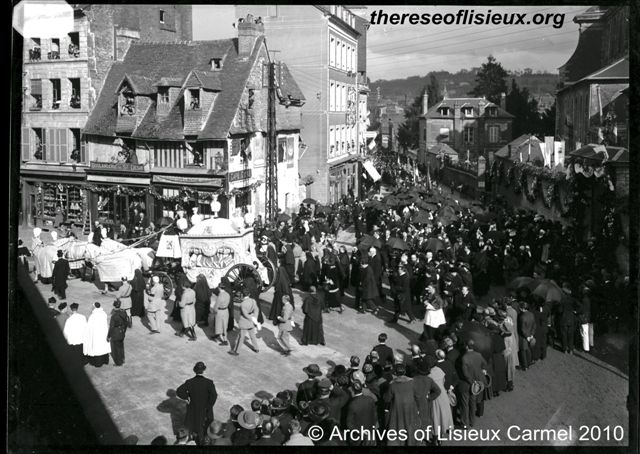 Thousands line the streets of Lisieux as the body of St. Therese, followed by many thousands, returns to the Carmel chapel, March 26, 1923. The crowd of pilgrims was estimated at between 30,000 and 50,000. After reaching the city, the procession moved very slowly through the streets, which were splendidly decorated with garlands, flags, trees, and triumphal arches. People from distant parts of the country waited for hours on the sidewalks, and the sloping roofs of the old Norman houses were lined with those who had come to witness the passing of "Little Sister Therese." As the procession passed, the demeanor of the crown [sic] was of touching respect. Not a word was heard; there was no pushing or craning; nothing but the motion of thousands of hands making the sign of the cross.
Thousands line the streets of Lisieux as the body of St. Therese, followed by many thousands, returns to the Carmel chapel, March 26, 1923. The crowd of pilgrims was estimated at between 30,000 and 50,000. After reaching the city, the procession moved very slowly through the streets, which were splendidly decorated with garlands, flags, trees, and triumphal arches. People from distant parts of the country waited for hours on the sidewalks, and the sloping roofs of the old Norman houses were lined with those who had come to witness the passing of "Little Sister Therese." As the procession passed, the demeanor of the crown [sic] was of touching respect. Not a word was heard; there was no pushing or craning; nothing but the motion of thousands of hands making the sign of the cross.
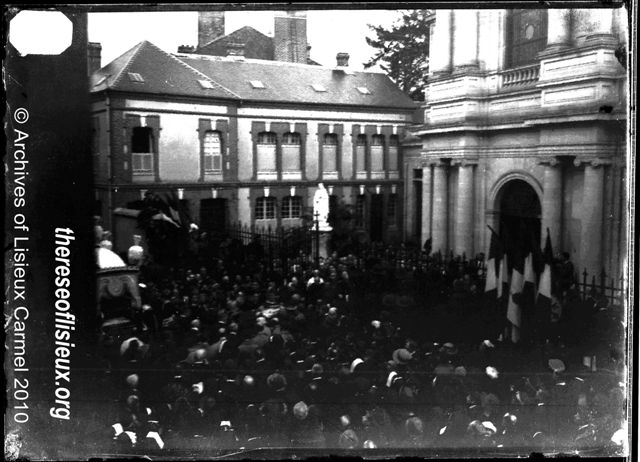
In front of the Carmelite chapel, the hearse stopped at last, and the coffin was borne into the illuminated choir, while a group of singers sang the hymn of Virgins to the accompaniment of a Handel choral, played on the new organ of the chapel which was used for the first time.
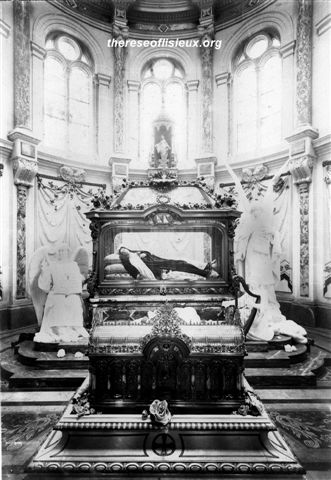 The reliquary of St. Therese at the Carmel of Lisieux
The reliquary of St. Therese at the Carmel of Lisieux
On the following day, the official recognition of the remains took place in the presence of two delegates of the Supreme Pontiff and two physicians.
NOTE: This contemporaneous account appeared in the Pittsburgh Catholic in April 1923, probably in the issue dated April 19, 1923
Editor's notes:
* This is a mistake; Therese was 15 when she entered.
**The first exhumation took place in 1910, the second in 1917.
*** "Outdoor" here is probably a translation of "extern sister," that is, a member of a cloistered religious community who is not enclosed and is responsible for receiving visitors, doing necessary errands, and otherwise serving as a liaison between the community and the world.
The photos with which this article is illustrated did not appear in the 1923 article in the Pittsburgh Catholic. They appear here thanks to the kindness of the Archives of the Carmel of Lisieux.
For an even more detailed account of the day, from the Archives of the Carmel of Lisieux, please visit "The Solemn Translation of St. Therese's Relics from the Town Cemetery to the Carmel of Lisieux, March 26, 1923."
Relics of St. Therese of Lisieux and of Sts. Louis and Zelie Martin to visit Chicago and of Minneapolis in the autumn of 2023
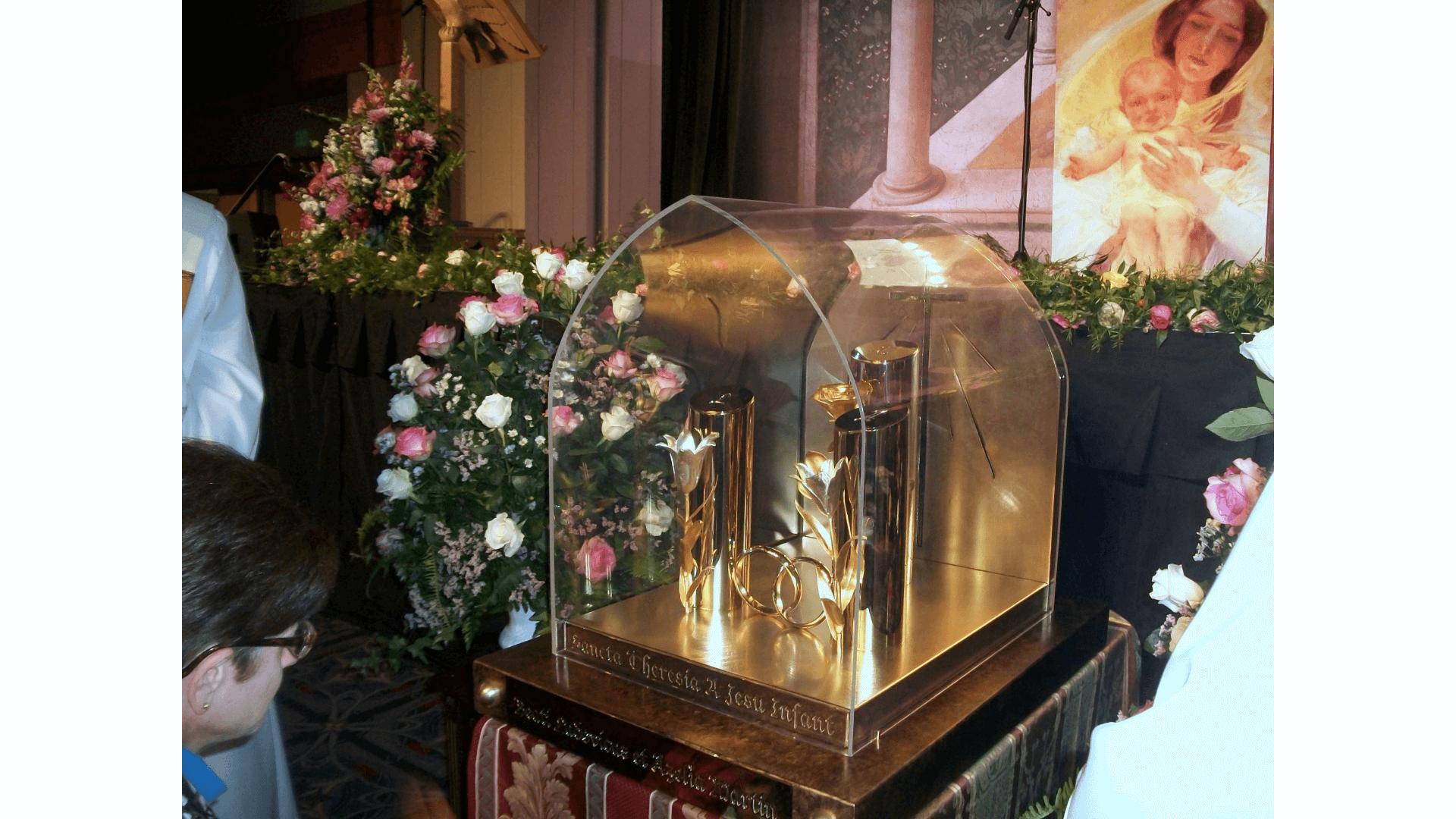 The "family reliquary" of St. Therese and Sts. Louis and Zelie Martin, entrusted by the Magnificat Foundation to the Archdiocese of Philadelphia, venerated during the Magnificat Day of Faith in Philadelphia, November 9, 2013 Relics of St. Therese of Lisieux and her parents, Sts. Louis and Zelie Martin, to visit Minneapolis and Chicago in the autumn of 2023
The "family reliquary" of St. Therese and Sts. Louis and Zelie Martin, entrusted by the Magnificat Foundation to the Archdiocese of Philadelphia, venerated during the Magnificat Day of Faith in Philadelphia, November 9, 2013 Relics of St. Therese of Lisieux and her parents, Sts. Louis and Zelie Martin, to visit Minneapolis and Chicago in the autumn of 2023
The Shrine at Lisieux has announced that the "Centenary Reliquary" of St. Therese of Lisieux and the traveling reliquary of Sts. Louis and Zelie Martin will jointly visit the American Midwest in the autumn of 2023. According to the Shrine's Web site, the relics will be in the Chicago area from September 16 to October 2, 2023. On October 3, 2023, they will travel to the Minneapolis area, where they will remain until October 16, 2023. I am sure that, when the itineraries are ready, the dioceses which are hosting the visits of the reliquaries will announce the local details.
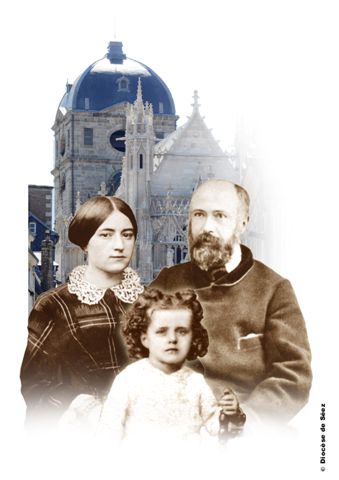 Composite photo of Sts. Louis and Zelie with three-year-old St. Therese against the background of Notre Dame Church in Alencon. Photo credit: Shrine of Sts. Louis and Zelie at Alencon.
Composite photo of Sts. Louis and Zelie with three-year-old St. Therese against the background of Notre Dame Church in Alencon. Photo credit: Shrine of Sts. Louis and Zelie at Alencon.
Important Anniversaries for the Martin Family
We are blessed that the relics are visiting the United States in this decade, during which we will celebrate many important anniversaries for the Martin saints:
- October 19, 2022 is the 25th anniversary of St. Therese's proclamation as a Doctor of the Church.
- January 2, 2023 is the 150th anniversary of the birth of St. Therese on January 2, 1873. In view of that anniversary, Therese has been recognized by UNESCO during 2022-2023 as a woman who contributed to the values of peace and culture.
- March 26, 2023 is the centenary of the solemn translation of the body of St. Therese from the municipal cemetery at Lisieux to her shrine at the Carmel (March 26, 1923).
- April 29, 2023 is the centenary of the beatification of St. Therese on April 29, 1923.
- August 22, 2023 is the bicentennial of the birth of St. Louis Martin in Bordeaux on August 22, 1823.
- May 17, 2025 is the centenary of St. Therese's canonization on May 17, 1925.
- December 14, 2027 is the centenary of St. Therese's proclamation as co-patron of missions.
- September 30, 2029 is the centenary of the laying of the cornerstone of the Basilica of St. Therese in Lisieux on September 30, 1929.
These anniversaries offer many opportunities for the Church to educate about the spirituality of Sts. Louis and Zelie and St. Therese. to reflect on how they inspire us, and to pray over their lives and their texts.
Photos of the two reliquaries
The Shrine's photos of the reliquaries are under copyright. Click to see the centenary reliquary (so called because it began to travel in 1997, the year of the centenary of the death of St. Therese). Click to see the traveling reliquary of Sts. Louis and Zelie Martin, which is a smaller replica of the reliquary in which their bodies repose in the crypt of the Basilica at Lisieux.
A call to prayer
The "centenary reliquary" of St. Therese has been on pilgrimage throughout the world since 1997. It visited the United States for about three months at the end of 1999 and was received by large and devout crowds. The reliquary of Sts. Louis and Zelie Martin has been on pilgrimage since 2015; I believe that 2023 marks its first visit to the United States. Let's begin to pray that the visit of the relics of the first saints canonized as a couple and of their daughter, a Doctor of the Church, will offer many opportunities for prayer, healing, evangelization, and receiving a flood of graces.
The story of St. Therese's baptism on January 4, 1873
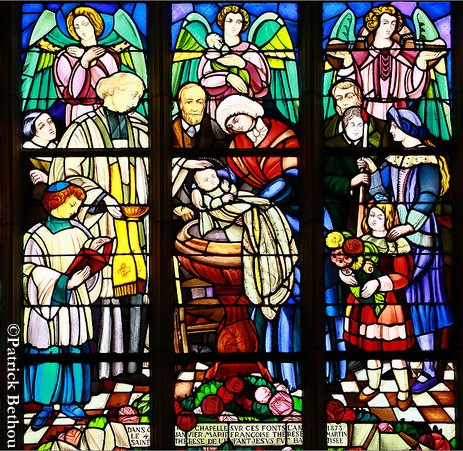
The baby Therese Martin, not yet two days old, was baptized at the Church of Our Lady of the Assumption [raised to the rank of a minor basilica after her parents were beatified in 2008] on the evening of Saturday, January 4, 1873.
Therese had been born at 11:30 at night on Thursday, January 2 in her parents’ house on rue Saint-Blaise in Alencon. This was the girlhood home of her mother, Zelie, but Louis and Zelie had moved into the house only in 1871. Thus, all eight of their older children had been baptized in the parish of St. Pierre de Montsort, where the Martins had lived for most of their marriage. Only Therese was baptized at “Notre Dame,” happily also the church in which Sts. Louis and Zelie had been married in 1858.
Fr. Lucien-Victor Dumaine, who baptized St. Therese
A medal depicting Fr. DumaineFr. Lucien-Victor Dumaine, then a vicar of Notre-Dame Church and a close friend of Therese’s father, Louis, baptized Therese. Later, he became vicar-general of the diocese of Seez (the bishop’s no. 2 man, the same role Fr. Reverony held later in the diocese of Bayeux and Lisieux when Therese wanted to enter Carmel). He testified at Therese’s diocesan process in 1910 and at her Apostolic Process in 1915. Thanks to the Web site of the Archives of the Carmel of Lisieux, from which the information about Fr. Dumaine is drawn and which I gratefully acknowledge, you may read Fr. Dumaine’s 1910 testimony about the Martin family here and his 1915 testimony about St. Therese's family here. As Fr. Dumaine was vicar of Notre Dame from 1868 to 1876, he knew the Martins well and was one of the few witnesses at the Process who could testify to the family’s life in Alencon. Because he later became vicar-general pf the diocese, he was also able to testify to Therese’s reputation for sanctity in the diocese of Seez, where she was born.
In 1910 Fr. Dumaine testified that he knew Therese’s family “intimately” and that he “knew . . . Marie, Pauline, Leonie, and Celine very well.” He had presided at the funeral of one of Therese’s little brothers. (Since this funeral took place at the parish of St. Pierre de Montsort, he was probably asked to preside because of his close friendship with St. Louis Martin). He added that he “heard the confessions of several members of the family.” This point is corroborated by a letter Zelie’s sister Marie-Louise, Sister Marie-Dosithee at the Monastery of the Visitation at Le Mans, wrote to her niece, Therese’s eldest sister Marie, then 16, on February 16, 1876:
Let us now come to piety. I am pleased that you appreciate the grace of having been brought up in the Visitation convent, yet you understand however that it will only do you as much good as the use you make of it; what use is it to have been brought up in the Visitation convent if you only have moderate piety and yet that’s what this is; you are moderately devout. I understand that M. Dumaine finds it difficult to allow you to take communion twice a month, you’re not pious enough. If you were more pious, he would certainly allow you daily communion if you had the required disposition.
You may read this letter from Sister Marie-Dosithee to Marie Martin on the Web site of the Archives of the Carmel of Lisieux.
In 1915, testifying about Therese’s reputation for sanctity in the diocese of Seez, M. Dumaine stated that “Several people have recommended themselves to my prayers for the very reason that I baptised the Servant of God myself.” He himself was devoted to Therese, prayed to her every day, and ardently wanted her cause to succeed.
Therese did not forget Fr. Dumaine. On July 23-24, 1912, speaking of Pope St. Pius X, Celine (Sister Genevieve) wrote to Leonie (Sister Francoise-Therese):
The Holy Father has just sent Fr Dumaine, who baptised Thérèse, a photo of our little sister that a prelate gave him, with a blessing written on the back. There’s nothing extraordinary about this, but what is touching is that the Holy Father withdrew to pray to Thérèse for a few minutes before writing it, asking her to heal the priest who had baptised her.1
The Pope prayed to Therese and inscribed the photo on July 8, 1912. Fr. Dumaine was then suffering terribly from stomach cancer. He survived until 1926, so he was still on earth when the little blonde baby he had baptized on that Saturday evening was canonized in 1925.
The baptismal ceremony
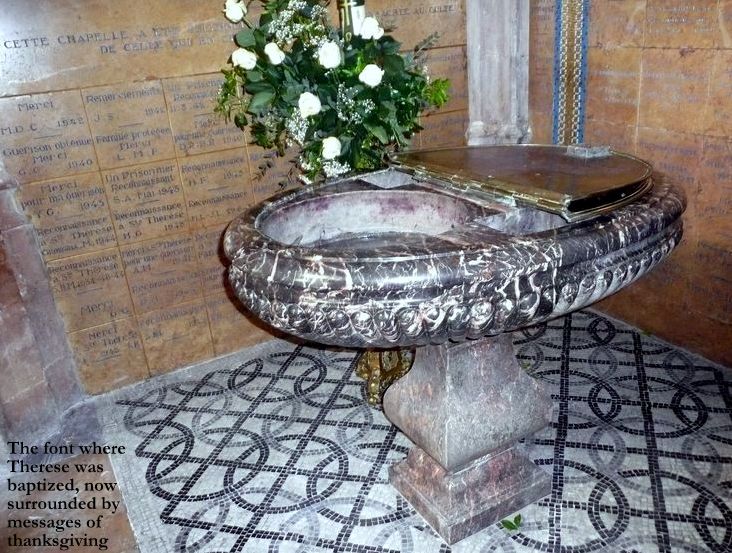
The baptistry of Notre Dame is located in an open “side-chapel” to the left as one enters the church. The baptismal font in which Therese was baptized is there today. St. Louis, of course, was present, but it seems that St. Zelie was not yet recovered enough to come. Therese was carried into the church by none other than Louise Marais, the maid who tormented Leonie. All Therese’s sisters were present. Her eldest sister, Marie, then almost 13, was her godmother. Therese's godfather was Paul-Albert Boul, a young man about Marie’s age who was the son of a friend of Louis Martin’s. Because this young man had been away on Friday, Therese’s baptism was postponed till Saturday evening, a delay which caused Zelie anxiety.
Later, an elaborate stained-glass window depicting Therese’s baptism was installed in the baptistry. To the right of the font depicted in the window the young godfather and his father stand near Marie, the godparents holding the baptismal candle; little Celine is near Marie. At the far left one glimpses the dark-haired Pauline. Although both M. Dumaine and Leonie testified that Leonie was present, and she signed the baptismal certificate along with the others, I can find no trace of the blonde Leonie, or of any fourth sister, in the window.
An altar and a statue of St. Therese were also added to the baptistry, with a plaque marking the saint's baptism.
The christening robe
A substantial portion of Therese’s christening robe is displayed above the font. But Therese was not the first to wear it: it had been given to Leonie by her generous godmother, Leonie Gilbert, later Mme. Jacques Tifenne. For the full story of the robe, please see my article “What is the mystery of Leonie Martin’s christening robe?”
Celine wrote two letters about the gift of this christening robe. On March 31, 1929 she wrote to Leonie:
Did you know that we’ve promised to give Notre-Dame church half of Thérèse’s baptism robe, on the condition that the awful stained-glass window in the baptistery is changed? Mgr Pasquet and the archpriest of N.-D. have reluctantly accepted our generous sacrifice. – I have therefore already divided up the robe. We’ll give the most beautiful half to Alençon, that is to say, the front of the dress with the pretty little bodice, and we’re keeping the back of the dress and little cloak.2
I do not know whether any changes were, in fact, made to the stained-glass window in the baptistry, but it seems that the first window installed incurred the Carmelites’ displeasure.
On January 24, 1934 Celine wrote to Leonie again, seeming to say that she was now going to give the back of the dress, not the front:
I’ve offered half of Thérèse’s baptism robe (the back of the skirt only), displayed in a pretty case, to the Baptistery in Alençon. It will be her gift to his Lordship, the Bishop of Séez, for [the Jubilee] on 8th May. We’re already preparing for it; it’s not too early.3
[The reference is to Octave-Louis Pasquet, appointed bishop of Seez in 1926. This Jubilee could have been the 50th anniversary of Therese’s First Communion, celebrated on May 8, 1934].
Therese's baptismal names
Therese was baptized Marie-Francoise-Therese. All the Martin daughters had the first name Marie; Francoise was to honor St. Francis de Sales, who greatly influenced the Order of the Visitation, which Zelie’s sister had joined; and, when she was expecting Therese, Zelie wrote “This child, like my last one [the little Marie-Melanie-Therese, who died at seven weeks] will be named Therese.”
Although Therese's name in religion was "Therese of the Child Jesus of the Holy Face," she remembered her baptismal names and used them on solemn occasions, for example, when she signed her "Offering of Myself as a Victim of Holocaust to Merciful Love" and her "Consecration to the Holy Face."4
Conclusion
In 2008, when I made my first visit to Notre Dame in Alencon, where a Pontifical Mass was celebrated the day before the beatification of Louis and Zelie, I prayed at the font in which Therese was baptized and had a deep sense of how much life-giving grace God has poured out on the Church and the world through Therese. I hope that many of the pilgrims who visit Notre Dame will renew their baptismal vows and, if they come as a family, invite their children to renew their own vows.
January 4, 2023 will be the 150th anniversary of the administration of this great sacrament to the "Doctor of the Science of Love," as Pope St. John Paul II called St. Therese. May we each live out the call to holiness we have received in baptism, and may our society reflect our corporate response to the universal call to holiness.
Notes
1 Letter from Sister Marie Dosithee to Marie Martin, February 6, 1876 on the Web site of the Archives of the Carmel of Lisieux (accessed January 4, 2022).
2 Letter from Celine (Sister Genevieve) to Leonie (Sister Francoise-Therese), March 31, 1929 on the Web site of the Archives of the Carmel of Lisieux (accessed January 4, 2022).
3 Letter from Celine (Sister Genevieve) to Leonie (Sister Francoise-Therese), January 24, 1934 on the Web site of the Archives of the Carmel of Lisieux (accessed January 4, 2022).
4 The Prayers of Saint Therese of Lisieux, tr. Aletheia Kane, O.C.D. Washington, D.C.: ICS Publications, 1997, pp. 53-74 ("Offering of myself as a victim of Holocaust to Merciful Love") and pp. 91-98 ("Act of Consecration to the Holy Face"). In footnote 2 to the latter, the editor notes that Therese used the initials of her own baptismal name and of the other two nuns who made this Consecration, saying "[Listing the baptismal names] is customary for the taking of vows and their annual renewal. Using it here confers on the Consecration a solemn character, which engages each sister's whole Christian being." (p. 95).
All rights to this article and its illustrations are reserved. To reproduce it, please apply for written permission.